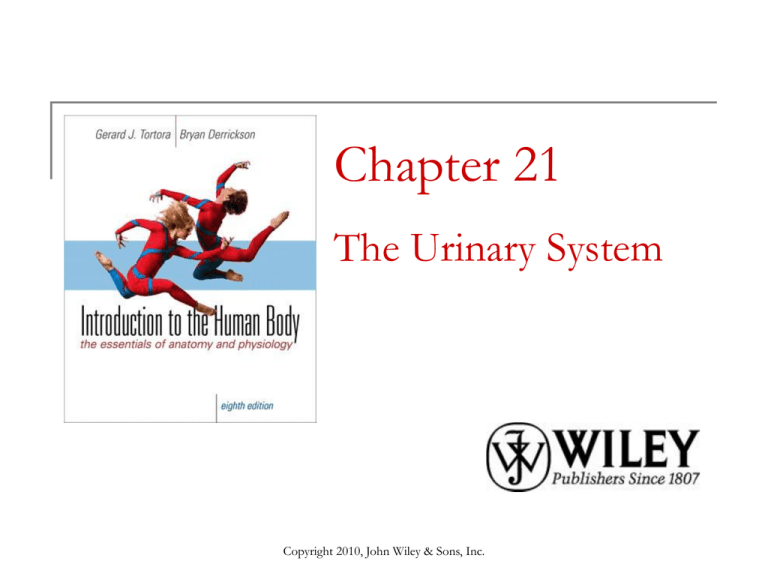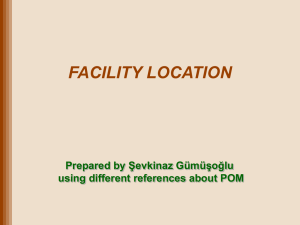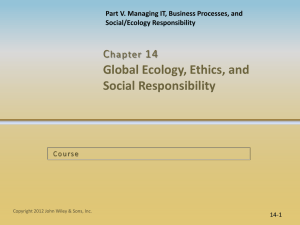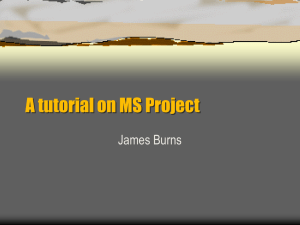
Chapter 21
The Urinary System
Copyright 2010, John Wiley & Sons, Inc.
End of Chapter 21
Copyright 2010 John Wiley & Sons, Inc.
All rights reserved. Reproduction or translation of
this work beyond that permitted in section 117 of the
1976 United States Copyright Act without express
permission of the copyright owner is unlawful.
Request for further information should be addressed
to the Permission Department, John Wiley & Sons,
Inc. The purchaser may make back-up copies for
his/her own use only and not for distribution or
resale. The Publishers assumes no responsibility
for errors, omissions, or damages caused by the use
of theses programs or from the use of the
information herein.
Copyright 2010, John Wiley & Sons, Inc.
Urinary System
Two kidneys and two ureters
Urinary bladder & urethra
Effector organ for
1.
2.
3.
4.
5.
Regulation of Plasma ion composition
Regulation of Body water Volume (BP)
Regulation of blood pH (with lung)
Production of Hormones
Excretion of waste
Copyright 2010, John Wiley & Sons, Inc.
Urinary System
Copyright 2010, John Wiley & Sons, Inc.
Kidney
Divided into cortex –outer portion
Medulla- inner portion
Urine goes into renal pelvis
Contain renal pyramids & renal columns
Edges are made of major & minor calyces
Then out ureter
Copyright 2010, John Wiley & Sons, Inc.
Kidney
Copyright 2010, John Wiley & Sons, Inc.
Renal Blood Supply
20-25% resting CO goes through kidneys
L. & R. renal arteries then
Segmental interlobar arcuate interlobular
afferent arterioles
glomerulus (capillary network)
efferent arterioles
peritubular capillaries veins
renal vein
Capillaris Units –nephrons grouped at pyramids
Copyright 2010, John Wiley & Sons, Inc.
Renal
Blood
Supply
Copyright 2010, John Wiley & Sons, Inc.
Renal Blood Supply
Copyright 2010, John Wiley & Sons, Inc.
Nephron
Unit of renal function: corpuscle & tubule
Corpuscle: forms filtrate
Glomerulus & Glomerular capsule (cortex)
Proximal convoluted tubule (cortex)
Descending Loop of Henle (into medulla)
ascending Loop of Henle (into medulla)
Distal convoluted tubule (cortex)
Collecting duct minor calyx
Copyright 2010, John Wiley & Sons, Inc.
Nephron
Copyright 2010, John Wiley & Sons, Inc.
Basic Operation
Glomerular filtration-filter plasma
Tubular reabsorption
Tubular Secretion
Reabsorb needed compounds & water from
filtrate
Secrete some materials into filtrate
Let rest go out as a solution called urine–see
Table 21.1
Copyright 2010, John Wiley & Sons, Inc.
Basic Operation
Copyright 2010, John Wiley & Sons, Inc.
Glomerular Filtration
Two layers of capsule surround glomerulus
Between is capsular space
Podocytes support capillary epithelium
Form filtration membrane
Permeable to water & solute
but not most proteins & blood cells
Copyright 2010, John Wiley & Sons, Inc.
Filtration Pressure
Blood pressure for filtration
Opposed by colloid osmotic pressure and
capsular pressure
Efferent and afferent arteriole diameters
adjust to maintain a net filtration pressure
Even with small changes in blood pressure
Copyright 2010, John Wiley & Sons, Inc.
Glomerular Filtration Rate
= GFR 105-125 ml/min
Determines net reabsorption because it
determines filtrate flow
ANP increases GFR
Responds to increased blood volume
Sympathetic stimulation vasoconstriction
decreased GFR
Urine production
Copyright 2010, John Wiley & Sons, Inc.
Glomerular Filtration
Copyright 2010, John Wiley & Sons, Inc.
Tubular Reabsorption
Proximal tubule
~65% Na+ & H2O
Normally 100% nutrients
~100% HCO3- (depends on blood pH)
Active transport of solutes
Osmosis moves water
Cells distal to proximal tubule fine tune
reabsorption under control
Copyright 2010, John Wiley & Sons, Inc.
Tubular Secretion
Takes place all along tubule
Major substances : H+, K+, ammonia, urea,
creatine, drugs like penicillin
Helps regulate plasma pH 7.35-7.45
Diet is acid urine is typically acidic
Copyright 2010, John Wiley & Sons, Inc.
Urine Route
Collecting ducts to calyces
Calyces to ureter
Ureter to bladder
Bladder to urethra
Copyright 2010, John Wiley & Sons, Inc.
Filtration, Reabsorption,
Secretion
Copyright 2010, John Wiley & Sons, Inc.
Hormonal Regulation
Angiotensin II & aldosterone
Angiotensin II- stimulates NaCl in proximal tube
Aldosterone- increases Na+ reabsorption & K+
secretion in DCT & CD
More ions reabsorbed more water
ANP-increases GFR & inhibits aldosterone
action less Na+ reabsorbed
ADH- responds to increased concentration of
solute in blood + fall in BP
Copyright 2010, John Wiley & Sons, Inc.
Hormonal Regulation
ADH: important to body water balance
Increased concentration of solute in blood +
fall in BP ADH
With no ADH: DCT & CD walls are
impermeable to water dilute urine
With ADH: water reabsorption occurs
concentrated urine
Copyright 2010, John Wiley & Sons, Inc.
Components of Urine
Urine = 1-2 l /day
95% water
+ urea, creatine, K+, ammonia, uric acid, Na+,
Cl-, Mg2+, sulfate, phosphate & Ca2+
Depends on diet and state of health
See table 21.3
Copyright 2010, John Wiley & Sons, Inc.
Regulation of
Water
Reabsorption
Copyright 2010, John Wiley & Sons, Inc.
Urine Route
Collecting ducts calyces
Ureter
Bladder- directly in front of rectum
Lined with mucus & transitional epithelium
Pass under bladder
Full bladder prevents backflow
Can stretch (700-800 ml)
Smaller in females because of uterus
Three layers of detrussor muscle
Urethra- internal urethral sphincter
External urethral sphincter (voluntary)
Copyright 2010, John Wiley & Sons, Inc.
Urine Route
Copyright 2010, John Wiley & Sons, Inc.
Micturition = Urination
Autonomic reflex- internal sphincter
Responds to stretch like rectum
Parasympathetic detrusor muscle
contraction
Conscious control-external sphincter
Copyright 2010, John Wiley & Sons, Inc.
Aging
Kidneys shrink- decrease in capacity
Thirst decreases dehydration
urinary tract infections
Males: prostate enlargement frequent
urination & slow flow
Females: more prone to leakage of external
sphincter (incontinence)
Both: nocturia
Copyright 2010, John Wiley & Sons, Inc.









